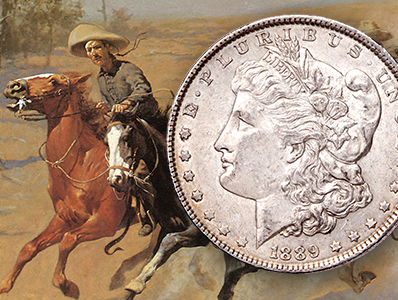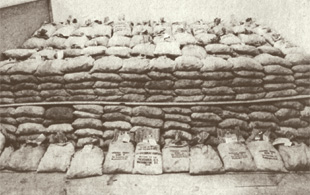Morgan Dollars
What is a Morgan Silver Dollar?
Large, heavy, handsome, historic and struck in .900 fine silver, the legendary Morgan silver dollar has been appropriately nicknamed the "King of America's Coins"! Morgan silver dollars are prized mementos of 19th-century America, and, as official issues of the United States Treasury, they are genuine pieces of history. These coins were minted when the nation was still young and life was indeed a daily adventure... a time of gunslingers, cattle barons, riverboat gamblers, railroad tycoons and dancehall queens. And a time when money meant large, hefty silver dollars, not credit cards and checkbooks!

Morgan silver dollars were first minted in 1878, during the heyday of the Wild West.
Morgan dollars were named after their designer, George T. Morgan, whose beautiful Liberty Head design was modeled after schoolteacher Anna Williams. They were struck at five U.S. Mints from 1878 to 1921, and circulated mainly in the West. The cowboys of the Old West dubbed the coins "cartwheels" because of their hefty size and weight.
Learn about starting a Morgan dollar collection.
The Legend of the Comstock Lode and Birth of the Morgan Dollar
In 1859, Patrick McLaughlin and Peter O'Riley were prospecting in Six Mile Canyon near Carson City, soon to be the capital of the Nevada territory. Digging a ditch to collect water, they found a rich black soil that yielded a layer of glittering ore. McLaughlin and O'Riley were experienced miners and instantly recognized gold. They eagerly began to wash away the heavy black soil.

Henry Comstock
In a few short hours, Henry Comstock came riding by on a borrowed pony. He was a colorful character and had a gift for gab. Without a shred of evidence, Comstock convinced McLaughlin and O'Riley that he had a claim on the very spot in which they had found gold. After a long argument, the two agreed to take Comstock in as a partner to avoid any trouble. Comstock talked so much of "his" mine that soon, hundreds of prospectors were swarming over Six Mile Canyon, washing away the black soil from the gold in the Comstock Mine.
J. F. Stone, a veteran of the California gold rush, was intrigued by the Comstock vein of gold in the Nevada territory. Curious about the heavy black soil being thrown aside by the ton, Stone sent a sample to be assayed in California. The soil turned out to be incredibly rich in silver, yielding $4,700 a ton. So enormous was this claim that over the next two decades, the Comstock Lode produced more than $300 million in precious metals – and that was in 19th-century dollars! Today, the Comstock Lode of Nevada is still known as the Queen of the Silver Strikes.
The Comstock Lode and other mines caused Nevada's population to grow ten-fold by 1880. Silver deposits played a very important role in the state's, as well as the nation's, history. Prior to the mine's discovery, silver was used sparingly for coinage, but afterward a flood of silver coins and dollars were struck. In fact, this abundance of silver and the fabulous Comstock Lode helped give birth to the Morgan silver dollar.
Troubled Beginnings
The Morgan silver dollar was first minted in 1878, after a lapse of five years in the production of silver dollars. The coin had a rough start, which would give the first-year-of-issue Morgan dollars an extra measure of interest and historical significance.
The trouble began five years before the first Morgans were minted. The Mint Act of February 1873 ended the production of the Liberty Seated silver dollars in favor of Trade and gold dollars. Silver dollars made up less than one percent of circulating silver and were considered too heavy and bulky by most of the public. Silver mine owners out West, however, were outraged. They lobbied and pressured their congressmen. After five years of heated debate, Congress finally authorized the production of a new silver dollar in 1878.
The Tail Feathers Controversy
The American Eagle on the reverse of the coin was also the subject of some controversy. On all previous U.S. coins, eagles had an uneven number of tail feathers, but Morgan's eagle had eight. There was widespread agreement that an uneven number of tail feathers was the proper representation of the bird. Under public pressure, the U.S. Mint decided to change the eagle's tail from eight to seven tail feathers. Since Philadelphia was the only mint that had struck Morgans, mint personnel gathered up all the unused 8-feather dies and simply re-struck them with the new 7-feather design. As a result, a small number of 1878 Morgan dollars have superimposed reverse designs and are known as the 7 over 8 Tail Feathers variety.
Eventually, newly engraved dies with the 7-feather design were used at the Philadelphia Mint. As a result, three varieties of the 1878 Morgan silver dollar were produced: 8 Tail Feathers, 7 Over 8 Tail Feathers, and the first 7 Tail Feathers coins – all without a mint mark. Later in 1878, the 7-feather coins were struck at both of the western mints – Carson City, Nevada, and San Francisco, California – making five distinct varieties of Morgans during its very first year of issue!

The five first-year varieties of Morgan Silver Dollars, left to right: the 8 Tail Feathers, the 7 Over 8 Tail Feathers, and the 7 Tail Feathers, all minted in Philadelphia; the 7 Tail Feathers "CC" from Carson City; and the 7 Tail Feathers "S" from San Francisco.
The "Silver Kings" Get Richer
When Morgan dollars were first issued, large quantities of silver were being mined at a time when very few industries needed silver. To make matters worse, Germany had converted to the gold standard and had dumped 8,000 tons of silver on the open market. To counteract this, western congressmen pushed through a bill that required the Treasury to purchase a certain amount of silver each month for silver dollar production. Silver prices continued to fall, however, as the demand for silver was not strong. The Sherman Silver Purchase Act of 1890 required the Treasury to buy over 140 tons of silver every month to mint silver dollars, while paying the silver mine owners in gold! This guaranteed a substantial income for the silver kings, but by the early 1890s, the rest of the United States was in serious financial shape.
By 1893, the Treasury vaults were bulging with silver dollars, while smaller silver coins were in very short supply. Huge payments to mine owners had nearly depleted the gold supply. But still, the Treasury was obligated to honor bonds and international debts, payable only in gold. The Treasury was facing default and Wall Street panicked – over 400 banks closed their doors in response to the country's financial situation. With the banks closed, many factories, stores and private citizens faced bankruptcy. The economy went into a tailspin and millions of Americans were suddenly jobless and hungry.
In November 1893, Congress repealed the Sherman Act and required the mints to use up remaining silver supplies. Dollar coinage became smaller and no more bullion was purchased for silver dollar production. Silver supplies ran out in 1904, temporarily ending the minting of Morgan silver dollars.
The 1921 Morgans
No one at the U.S. Mint expected the Morgan silver dollar to ever again be minted. The dies were ordered destroyed. The Pittman Act of 1918 authorized the U.S. government to melt down as much as $350 million worth of silver dollars, and the resulting bullion was sold to Great Britain and shipped to India. This British colony's currency was to be backed by the silver bullion from America.
To stabilize the price of silver, the Act also stipulated that the government was to buy an equivalent amount of domestic silver to replace those coins that were melted down. The Act proved advantageous in a number of ways. The British government got the silver it needed to back India's currency; the U.S. government received revenue from the millions of silver dollars stored in Treasury vaults; and the American silver industry was revitalized.
In February 1921, after a lapse of 17 years, three U.S. Mints began to strike Morgan dollars again. Both the Philadelphia and San Francisco Mints had struck these coins previously. But Denver had opened in 1906, and this year marked first and only time Morgan silver dollars would bear the "D" Denver mint mark.
The Morgan silver dollars, though briefly revived a final time in 1921, were struck for less than a year and then their production was ceased permanently. They were replaced in 1921 by Anthony de Francisci's Peace dollars.
The Forgotten Hoard of Morgan Silver Dollars
Although relatively few people used silver dollars (particularly in the East where paper money was favored), the government continued to produce them due to political pressure from silver-mining interests. Consequently, millions of the coins were stored away in government vaults. They remained there until 1918, when the Pittman Act sent millions of them to the melting pot to help finance the military effort during World War I.

Nearly 3,000 bags of silver dollars – most of them from the Carson City Mint – were found in the vaults of the main Treasury building in Washington, D.C. The final tally was over 2.8 million "CC" Morgan silver dollars!
In the early 1960s, when the U.S. Mint stopped producing coins in .900 fine silver and stopped redeeming paper money in silver dollars, the government made an accounting of silver dollars still in storage. To everyone's surprise, a hoard of Uncirculated Carson City Morgan silver dollars was discovered in a forgotten corner of the main Treasury building in Washington! Since the coins were scarce and in great demand among collectors, the government decided to seal them in special holders and sell them to the public.
The Treasury anticipated an enthusiastic response, but the flood of orders they received was beyond all expectations! In the final sale of 1980, more than 400,000 orders were received, and over 200,000 orders had to be turned away unfilled! It was a great day for collectors when those mint-sealed bags of silver dollars were released to the public, and that special sale ignited a surge of popularity in the Morgan dollar series. This popularity remains just as strong today, making the Morgan silver dollar the most collected silver coin in the world!
Read more...
Back to U.S. Coins By Type
